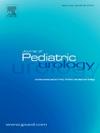接受早期非甾体抗炎药治疗的下尿路重建术后发生急性肾损伤的风险:倾向匹配回顾性分析
IF 2
3区 医学
Q2 PEDIATRICS
引用次数: 0
摘要
导言:阿片类药物的流行导致术后非阿片类镇痛的使用增加。一些小儿泌尿科医生因担心引起急性肾损伤(AKI)而不常规使用非甾体类抗炎药(NSAID)。虽然之前的研究已经证明了非甾体抗炎药在儿童中的安全性和有效性,但下尿路重建后的安全性还没有得到很好的描述:研究设计2-18 岁接受下尿路重建术(即膀胱增容和/或创建尿道)的患者、研究对 2009 年至 2021 年期间接受下尿路重建手术(即膀胱扩容术和/或建立可导尿通道)并有尿量记录的 2-18 岁患者进行了回顾性研究。根据术后 6 个月内的肌酐和胱抑素 C,采用 CKiD U25 方程计算慢性肾病 (CKD) 分期。接受非甾体抗炎药治疗的患者与接受类似手术但未接受非甾体抗炎药治疗的患者在 11 项特征上进行了倾向匹配。主要结果是术后48小时内AKI的发生率。倾向匹配确定了166名患者接受非甾体抗炎药治疗,41名患者未接受非甾体抗炎药治疗。其中包括 26 名 CKD 2-3 期患者。根据KDIGO标准,术后AKI发生率无明显差异(无NSAID组17.1%对NSAID组16.3%,P = 0.87)。术后阿片类药物的中位数从无NSAID组的0.88 mg/kg降至NSAID组的0.37 mg/kg吗啡当量,但无统计学意义。卡普兰-梅尔分析的对数秩检验表明,两组患者发生低尿量的时间没有差异(p = 0.32)。讨论在下尿路重建术后接受和未接受非甾体抗炎药治疗的患者中,术后 AKI 的发生率没有差异,不包括晚期 CKD 患者。然而,无论是否使用非甾体抗炎药,这些手术后仍有发生 AKI 的风险,这可能是由于潜在疾病、手术时间较长以及体液转移所致。在手术室或术后 6 小时内服用和未服用非甾体抗炎药的患者术后 AKI 的发生率空细胞无非甾体抗炎药非甾体抗炎药P值41例患者166例患者急性肾损伤(任何标准)2077(17.1%)27(16.3%)0.急性肾损伤(标准 1)383 (23.1%)3 (12.0%)0.895急性肾损伤(标准 2)414 (28.6%)10 (37.0%)0.380急性肾损伤(标准 3)2072 (4.9%)17 (10.2%)0.618平均住院时间(IQR),天数2075.3 (4.2-7.1)4.5 (3.4-6.3)0.970本文章由计算机程序翻译,如有差异,请以英文原文为准。
Risk of acute kidney injury after lower urinary tract reconstruction with early NSAID therapy: A propensity matched retrospective analysis
Introduction
The opioid epidemic response led to increased use of postoperative, non-opioid analgesia. Some pediatric urologists do not routinely use non-steroidal anti-inflammatory drugs (NSAIDs) for fear of causing acute kidney injury (AKI). While previous studies have demonstrated the safety and efficacy of NSAIDs in children, safety after lower urinary tract reconstruction has not been well characterized.
Objective
ptUsing the Kidney Disease: Improving Global Outcomes (KDIGO) criteria for AKI (increase in creatinine ≥0.3 mg/dL or increase in creatinine ≥1.5x baseline or urine output <0.5 mL/kg/hr for 6 h), we hypothesized there would be a difference in the incidence of postoperative AKI between patients who did and did not receive NSAIDs following surgery.
Study design
Patients 2–18 years old who underwent lower urinary tract reconstruction (i.e., bladder augmentation and/or creation of a catheterizable channel) from 2009 to 2021 and had documented urine output were retrospectively reviewed. Chronic kidney disease (CKD) stage was calculated from creatinine and cystatin C within 6 months of surgery using the CKiD U25 equations. Patients who received NSAIDs were propensity matched on 11 characteristics with patients undergoing similar surgeries who did not receive NSAIDs. The primary outcome was incidence of AKI within 48 h of surgery.
Results
The unmatched cohorts included 243 patients. Propensity matching identified 166 patients in the NSAID arm and 41 in the no NSAID arm. 26 patients with CKD stage 2–3 were included. There was no significant difference in the incidence of postoperative AKI based on any KDIGO criteria (17.1% no NSAID versus 16.3% NSAID, p = 0.87). Median postoperative opioids fell from 0.88 mg/kg in the no NSAID arm to 0.37 mg/kg morphine equivalents in the NSAID arm, although this was not statistically significant. Log-rank testing by Kaplan–Meier analysis demonstrated no difference in time to incidence of low urine output between the groups (p = 0.32). In the whole population not stratified by NSAID use, no differences were seen in AKI between those with and without CKD (16.7% with versus 17.9% without CKD).
Discussion
There was no difference in the incidence of postoperative AKI among patients who did and did not receive NSAIDs after lower urinary tract reconstruction, excluding those with advanced CKD.
Conclusion
These results support that postoperative NSAIDs were an unlikely source of AKI. However, AKI remained a risk following these surgeries, regardless of NSAID use, likely owing to underlying disease, longer operations, and fluid shifts.
Summary Table. Incidence of postoperative AKI among patients who did and did not receive NSAIDs in the operating room or within 6 h after surgery.
| Empty Cell | n | No NSAID | NSAID | P value |
|---|---|---|---|---|
| 41 patients | 166 patients | |||
| Acute kidney injury (any criteria) | 207 | 7 (17.1%) | 27 (16.3%) | 0.875 |
| Acute kidney injury (criteria 1) | 38 | 3 (23.1%) | 3 (12.0%) | 0.895 |
| Acute kidney injury (criteria 2) | 41 | 4 (28.6%) | 10 (37.0%) | 0.380 |
| Acute kidney injury (criteria 3) | 207 | 2 (4.9%) | 17 (10.2%) | 0.618 |
| Median length of stay (IQR), days | 207 | 5.3 (4.2–7.1) | 4.5 (3.4–6.3) | 0.970 |
求助全文
通过发布文献求助,成功后即可免费获取论文全文。
去求助
来源期刊

Journal of Pediatric Urology
PEDIATRICS-UROLOGY & NEPHROLOGY
CiteScore
3.70
自引率
15.00%
发文量
330
审稿时长
4-8 weeks
期刊介绍:
The Journal of Pediatric Urology publishes submitted research and clinical articles relating to Pediatric Urology which have been accepted after adequate peer review.
It publishes regular articles that have been submitted after invitation, that cover the curriculum of Pediatric Urology, and enable trainee surgeons to attain theoretical competence of the sub-specialty.
It publishes regular reviews of pediatric urological articles appearing in other journals.
It publishes invited review articles by recognised experts on modern or controversial aspects of the sub-specialty.
It enables any affiliated society to advertise society events or information in the journal without charge and will publish abstracts of papers to be read at society meetings.
 求助内容:
求助内容: 应助结果提醒方式:
应助结果提醒方式:


